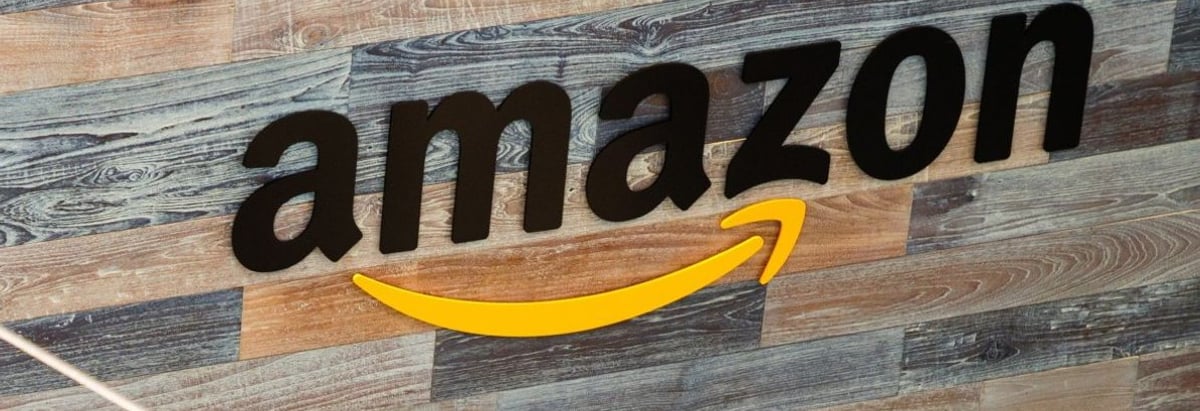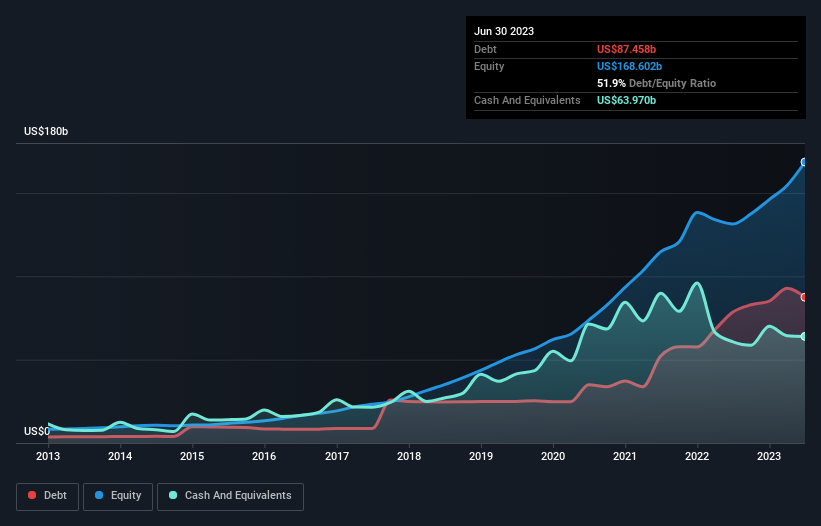Stock Analysis
- United States
- /
- General Merchandise and Department Stores
- /
- NasdaqGS:AMZN
Here's Why Amazon.com (NASDAQ:AMZN) Can Manage Its Debt Responsibly

The external fund manager backed by Berkshire Hathaway's Charlie Munger, Li Lu, makes no bones about it when he says 'The biggest investment risk is not the volatility of prices, but whether you will suffer a permanent loss of capital.' So it seems the smart money knows that debt - which is usually involved in bankruptcies - is a very important factor, when you assess how risky a company is. As with many other companies Amazon.com, Inc. (NASDAQ:AMZN) makes use of debt. But the real question is whether this debt is making the company risky.
What Risk Does Debt Bring?
Debt is a tool to help businesses grow, but if a business is incapable of paying off its lenders, then it exists at their mercy. In the worst case scenario, a company can go bankrupt if it cannot pay its creditors. However, a more usual (but still expensive) situation is where a company must dilute shareholders at a cheap share price simply to get debt under control. Of course, plenty of companies use debt to fund growth, without any negative consequences. The first step when considering a company's debt levels is to consider its cash and debt together.
See our latest analysis for Amazon.com
What Is Amazon.com's Net Debt?
As you can see below, at the end of June 2023, Amazon.com had US$87.5b of debt, up from US$78.5b a year ago. Click the image for more detail. However, it does have US$64.0b in cash offsetting this, leading to net debt of about US$23.5b.

How Healthy Is Amazon.com's Balance Sheet?
According to the last reported balance sheet, Amazon.com had liabilities of US$148.2b due within 12 months, and liabilities of US$160.8b due beyond 12 months. On the other hand, it had cash of US$64.0b and US$34.9b worth of receivables due within a year. So its liabilities total US$210.1b more than the combination of its cash and short-term receivables.
Since publicly traded Amazon.com shares are worth a very impressive total of US$1.34t, it seems unlikely that this level of liabilities would be a major threat. But there are sufficient liabilities that we would certainly recommend shareholders continue to monitor the balance sheet, going forward.
We measure a company's debt load relative to its earnings power by looking at its net debt divided by its earnings before interest, tax, depreciation, and amortization (EBITDA) and by calculating how easily its earnings before interest and tax (EBIT) cover its interest expense (interest cover). This way, we consider both the absolute quantum of the debt, as well as the interest rates paid on it.
Amazon.com has a low net debt to EBITDA ratio of only 0.37. And its EBIT covers its interest expense a whopping 18.1 times over. So we're pretty relaxed about its super-conservative use of debt. And we also note warmly that Amazon.com grew its EBIT by 14% last year, making its debt load easier to handle. When analysing debt levels, the balance sheet is the obvious place to start. But it is future earnings, more than anything, that will determine Amazon.com's ability to maintain a healthy balance sheet going forward. So if you want to see what the professionals think, you might find this free report on analyst profit forecasts to be interesting.
Finally, a business needs free cash flow to pay off debt; accounting profits just don't cut it. So we clearly need to look at whether that EBIT is leading to corresponding free cash flow. Over the last three years, Amazon.com saw substantial negative free cash flow, in total. While investors are no doubt expecting a reversal of that situation in due course, it clearly does mean its use of debt is more risky.
Our View
Amazon.com's conversion of EBIT to free cash flow was a real negative on this analysis, although the other factors we considered were considerably better. In particular, we are dazzled with its interest cover. When we consider all the elements mentioned above, it seems to us that Amazon.com is managing its debt quite well. Having said that, the load is sufficiently heavy that we would recommend any shareholders keep a close eye on it. Over time, share prices tend to follow earnings per share, so if you're interested in Amazon.com, you may well want to click here to check an interactive graph of its earnings per share history.
At the end of the day, it's often better to focus on companies that are free from net debt. You can access our special list of such companies (all with a track record of profit growth). It's free.
What are the risks and opportunities for Amazon.com?
Amazon.com, Inc. engages in the retail sale of consumer products and subscriptions through online and physical stores in North America and internationally.
Rewards
Trading at 21.8% below our estimate of its fair value
Earnings are forecast to grow 28.03% per year
Earnings have grown 3.4% per year over the past 5 years
Risks
No risks detected for AMZN from our risks checks.
Further research on
Amazon.com
Have feedback on this article? Concerned about the content? Get in touch with us directly. Alternatively, email editorial-team (at) simplywallst.com.
This article by Simply Wall St is general in nature. We provide commentary based on historical data and analyst forecasts only using an unbiased methodology and our articles are not intended to be financial advice. It does not constitute a recommendation to buy or sell any stock, and does not take account of your objectives, or your financial situation. We aim to bring you long-term focused analysis driven by fundamental data. Note that our analysis may not factor in the latest price-sensitive company announcements or qualitative material. Simply Wall St has no position in any stocks mentioned.